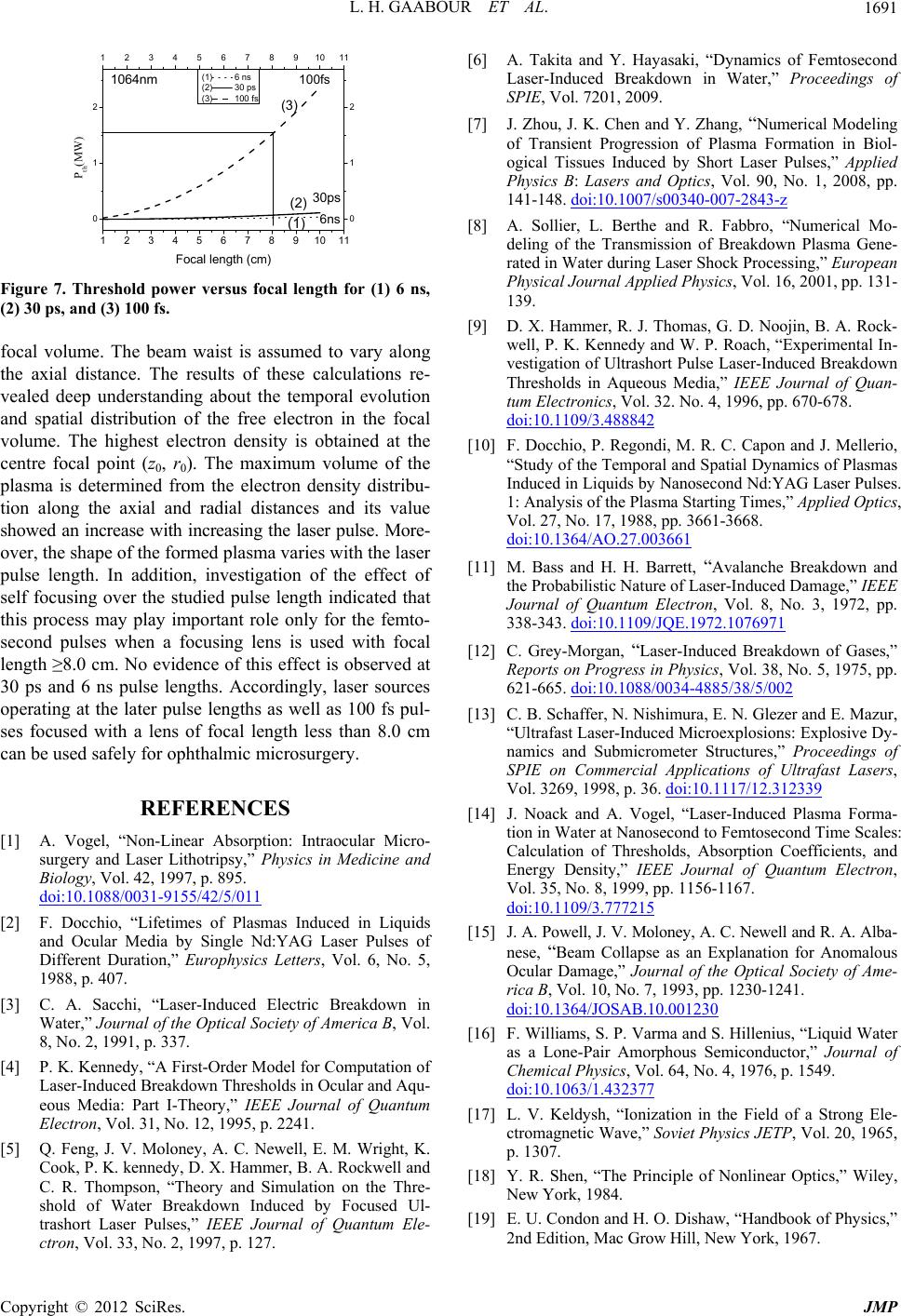
L. H. GAABOUR ET AL.
Copyright © 2012 SciRes. JMP
1691
7891011
[6] A. Takita and Y. Hayasaki, “Dynamics of Femtosecond
Laser-Induced Breakdown in Water,” Proceedings of
SPIE, Vol. 7201, 2009.
123456
1234567891011
0
1
2
0
1
2
(1) 6 ns
(2) 30 ps
(3) 100 fs
1064nm
Pth(MW)
Focal leng th (c
6ns
30ps
100fs
m)
(3)
(2)
(1)
[7] J. Zhou, J. K. Chen and Y. Zhang, “Numerical Modeling
of Transient Progression of Plasma Formation in Biol-
ogical Tissues Induced by Short Laser Pulses,” Applied
Physics B: Lasers and Optics, Vol. 90, No. 1, 2008, pp.
141-148. doi:10.1007/s00340-007-2843-z
[8] A. Sollier, L. Berthe and R. Fabbro, “Numerical Mo-
deling of the Transmission of Breakdown Plasma Gene-
rated in Water during Laser Shock Processing,” European
Physical Journal Applied Physics, Vol. 16, 2001, pp. 131-
139.
Figure 7. Threshold power versus focal length for (1) 6 ns,
(2) 30 ps, and (3) 100 fs.
[9] D. X. Hammer, R. J. Thomas, G. D. Noojin, B. A. Rock-
well, P. K. Kennedy and W. P. Roach, “Experimental In-
vestigation of Ultrashort Pulse Laser-Induced Breakdown
Thresholds in Aqueous Media,” IEEE Journal of Quan-
tum Electronics, Vol. 32. No. 4, 1996, pp. 670-678.
doi:10.1109/3.488842
focal volume. The beam waist is assumed to vary along
the axial distance. The results of these calculations re-
vealed deep understanding about the temporal evolution
and spatial distribution of the free electron in the focal
volume. The highest electron density is obtained at the
centre focal point (z0, r0). The maximum volume of the
plasma is determined from the electron density distribu-
tion along the axial and radial distances and its value
showed an increase with increasing the laser pulse. More-
over, the shape of the formed plasma varies with the laser
pulse length. In addition, investigation of the effect of
self focusing over the studied pulse length indicated that
this process may play important role only for the femto-
second pulses when a focusing lens is used with focal
length ≥8.0 cm. No evidence of this effect is observed at
30 ps and 6 ns pulse lengths. Accordingly, laser sources
operating at the later pulse lengths as well as 100 fs pul-
ses focused with a lens of focal length less than 8.0 cm
can be used safely for ophthalmic microsurgery.
[10] F. Docchio, P. Regondi, M. R. C. Capon and J. Mellerio,
“Study of the Temporal and Spatial Dynamics of Plasmas
Induced in Liquids by Nanosecond Nd:YAG Laser Pulses.
1: Analysis of the Plasma Starting Times,” Applied Optics,
Vol. 27, No. 17, 1988, pp. 3661-3668.
doi:10.1364/AO.27.003661
[11] M. Bass and H. H. Barrett, “Avalanche Breakdown and
the Probabilistic Nature of Laser-Induced Damage,” IEEE
Journal of Quantum Electron, Vol. 8, No. 3, 1972, pp.
338-343. doi:10.1109/JQE.1972.1076971
[12] C. Grey-Morgan, “Laser-Induced Breakdown of Gases,”
Reports on Progress in Physics, Vol. 38, No. 5, 1975, pp.
621-665. doi:10.1088/0034-4885/38/5/002
[13] C. B. Schaffer, N. Nishimura, E. N. Glezer and E. Mazur,
“Ultrafast Laser-Induced Microexplosions: Explosive Dy-
namics and Submicrometer Structures,” Proceedings of
SPIE on Commercial Applications of Ultrafast Lasers,
Vol. 3269, 1998, p. 36. doi:10.1117/12.312339
REFERENCES [14] J. Noack and A. Vogel, “Laser-Induced Plasma Forma-
tion in Water at Nanosecond to Femtosecond Time Scales:
Calculation of Thresholds, Absorption Coefficients, and
Energy Density,” IEEE Journal of Quantum Electron,
Vol. 35, No. 8, 1999, pp. 1156-1167.
doi:10.1109/3.777215
[1] A. Vogel, “Non-Linear Absorption: Intraocular Micro-
surgery and Laser Lithotripsy,” Physics in Medicine and
Biology, Vol. 42, 1997, p. 895.
doi:10.1088/0031-9155/42/5/011
[2] F. Docchio, “Lifetimes of Plasmas Induced in Liquids
and Ocular Media by Single Nd:YAG Laser Pulses of
Different Duration,” Europhysics Letters, Vol. 6, No. 5,
1988, p. 407.
[15] J. A. Powell, J. V. Moloney, A. C. Newell and R. A. Alba-
nese, “Beam Collapse as an Explanation for Anomalous
Ocular Damage,” Journal of the Optical Society of Ame-
rica B, Vol. 10, No. 7, 1993, pp. 1230-1241.
doi:10.1364/JOSAB.10.001230
[3] C. A. Sacchi, “Laser-Induced Electric Breakdown in
Water,” Journal of the Optical Society of America B, Vol.
8, No. 2, 1991, p. 337. [16] F. Williams, S. P. Varma and S. Hillenius, “Liquid Water
as a Lone-Pair Amorphous Semiconductor,” Journal of
Chemical Physics, Vol. 64, No. 4, 1976, p. 1549.
doi:10.1063/1.432377
[4] P. K. Kennedy, “A First-Order Model for Computation of
Laser-Induced Breakdown Thresholds in Ocular and Aqu-
eous Media: Part I-Theory,” IEEE Journal of Quantum
Electron, Vol. 31, No. 12, 1995, p. 2241. [17] L. V. Keldysh, “Ionization in the Field of a Strong Ele-
ctromagnetic Wave,” Soviet Physics JETP, Vol. 20, 1965,
p. 1307.
[5] Q. Feng, J. V. Moloney, A. C. Newell, E. M. Wright, K.
Cook, P. K. kennedy, D. X. Hammer, B. A. Rockwell and
C. R. Thompson, “Theory and Simulation on the Thre-
shold of Water Breakdown Induced by Focused Ul-
trashort Laser Pulses,” IEEE Journal of Quantum Ele-
ctron, Vol. 33, No. 2, 1997, p. 127.
[18] Y. R. Shen, “The Principle of Nonlinear Optics,” Wiley,
New York, 1984.
[19] E. U. Condon and H. O. Dishaw, “Handbook of Physics,”
2nd Edition, Mac Grow Hill, New York, 1967.